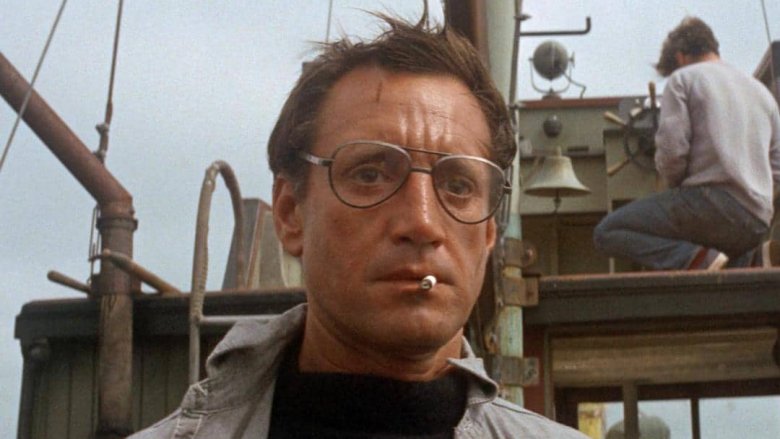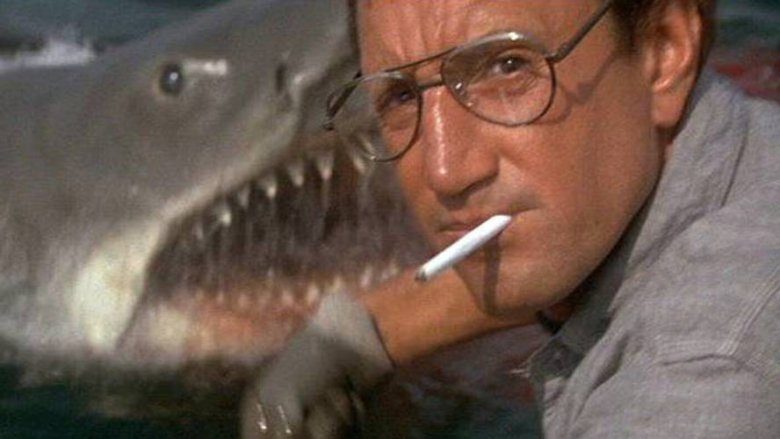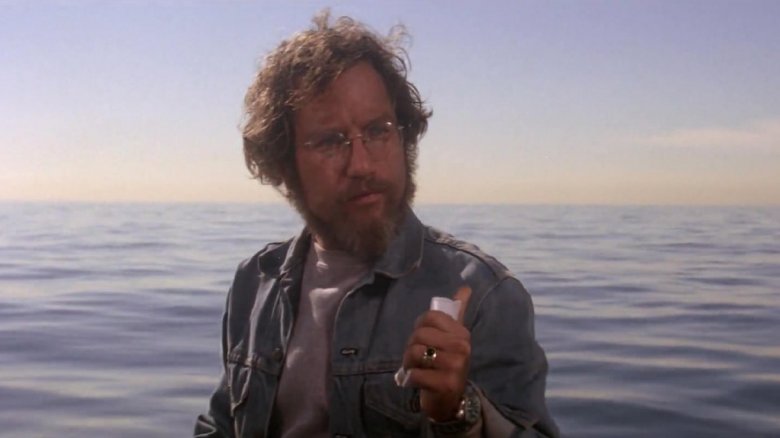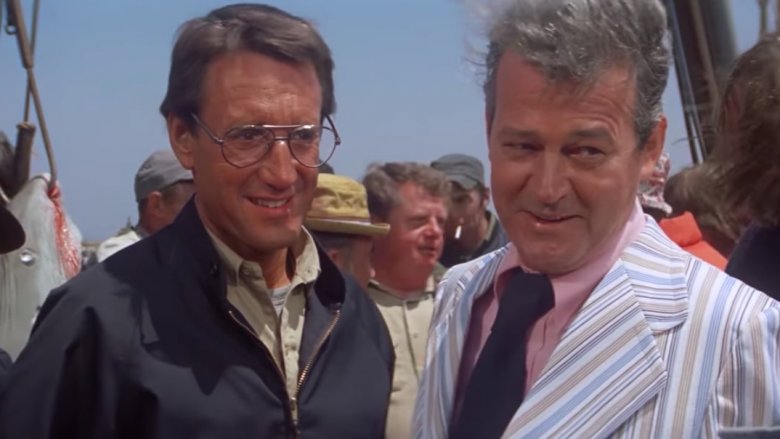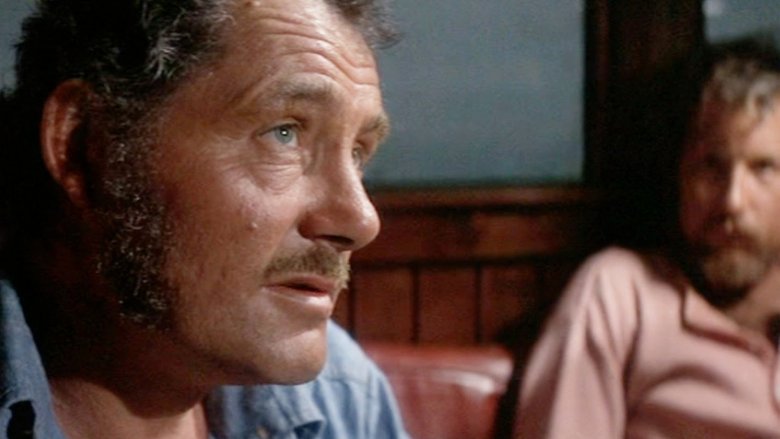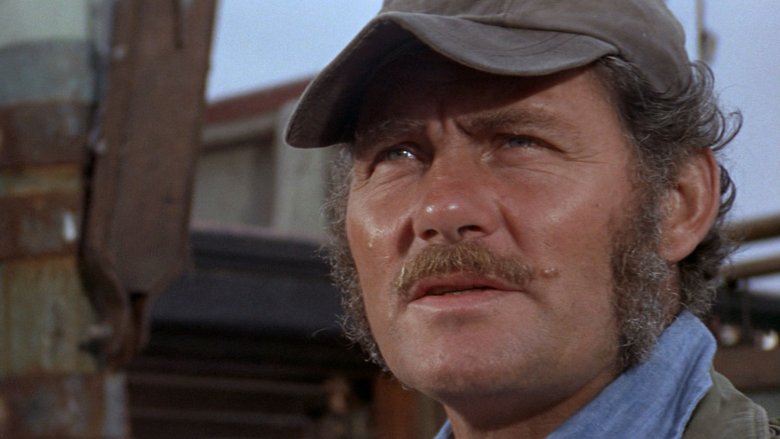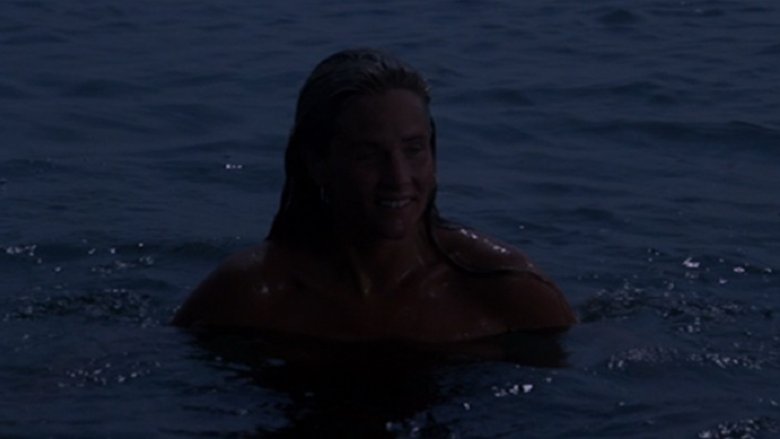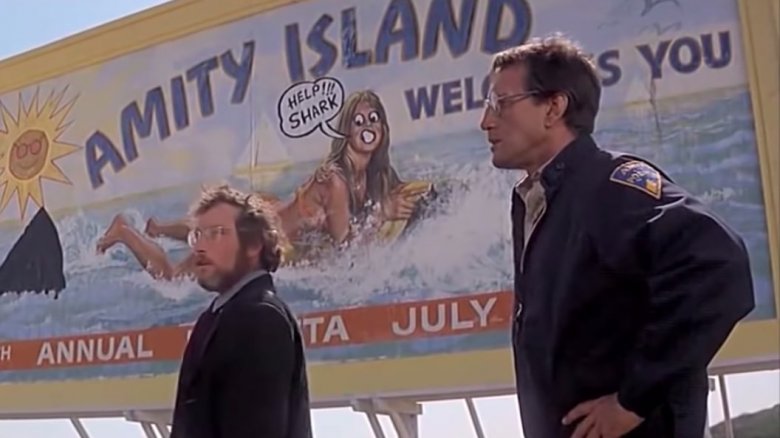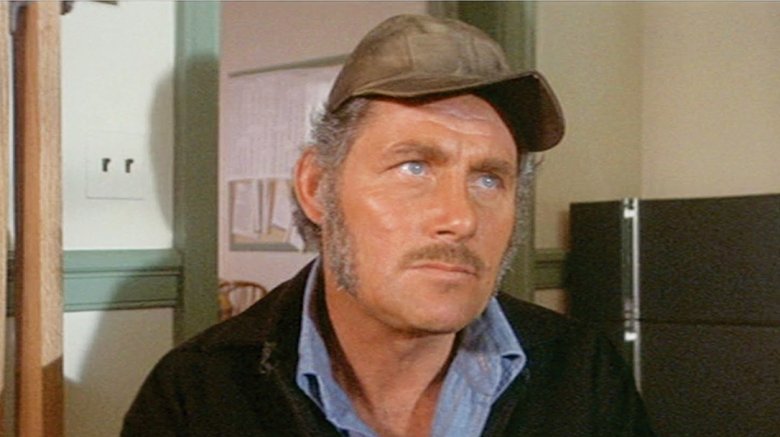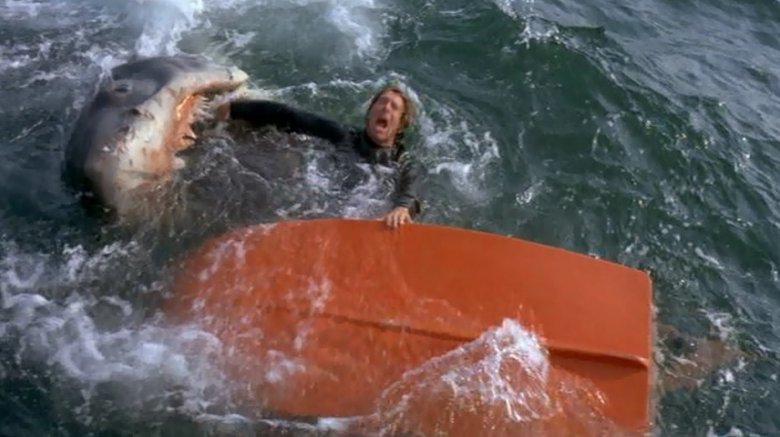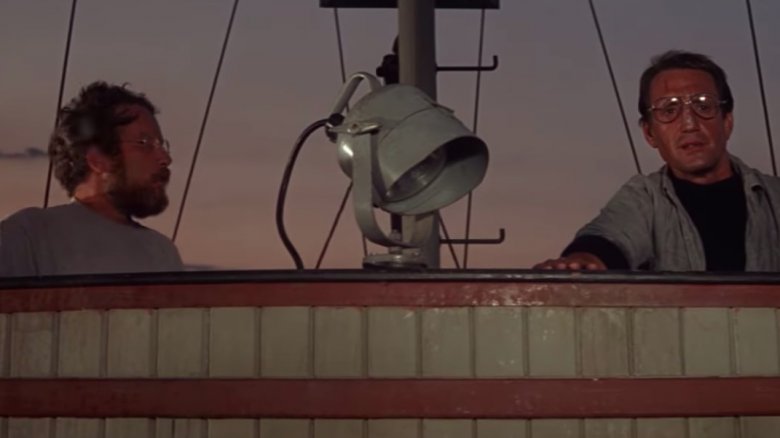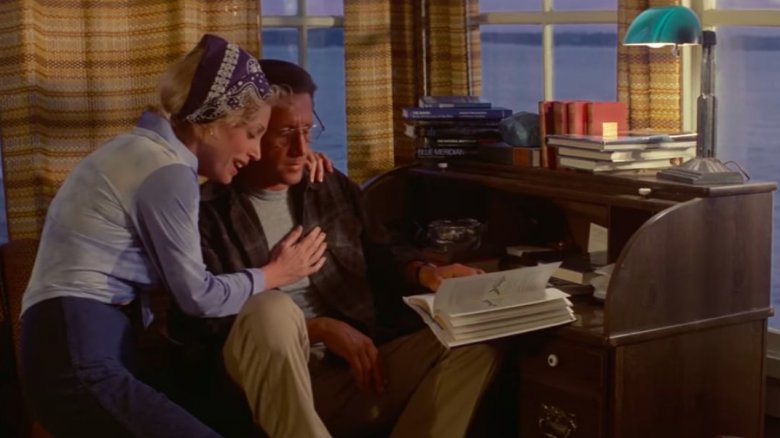Dumb Things In Jaws Everyone Ignored
When Steven Spielberg's Jaws was released in 1975, the thriller became the first real summer blockbuster in the history of American cinema. Based on Peter Benchley's novel of the same name, the film finds a great white shark with a taste for carefree beachgoers terrorizing the idyllic New England resort town on Amity Island, leaving stoic police chief Martin Brody (Roy Scheider), curious oceanographer Matt Hooper (Richard Dreyfuss), and grizzled shark hunter Quint (Robert Shaw) to find and kill the fish for themselves. Audiences found themselves simultaneously frightened of and fascinated by sharks, and the simple, two-note theme song is still widely recognizable today. Jaws made such a lasting cultural impact that it in 2001, the Library of Congress specifically selected the film for preservation.
Despite the genius of a film like Jaws — a straightforward plot with an unthinking, unfeeling villain that plays on our most primal fears — there are quite a few mistakes in the movie. References to historical events don't always check out, there are several obvious on-screen gaffs, and some of the characters' claims about sharks would leave a marine biologist shaking their head. The next time you watch Jaws, keep an eye out for these silly screw-ups that everyone just ignored.
The 'rogue shark' theory
Make no mistake, Jaws is a classic for good reason. From the memorable score and the iconic quotes to the horrifying shark attack scenes that made viewers hesitate to head to the beach, there's a reason it won several Oscars and still holds up decades after its release. Unfortunately, the entire premise of the film is based on a shoddy scientific theory that has been thoroughly debunked.
Hooper suspects that the shark is a "rogue," referring to the outdated "rogue shark" theory. The idea was that certain individual sharks could go "rogue" and intentionally hunt humans, growing to prefer their taste to that of seals and fish, which are usually on the menu. Thankfully, the truth isn't nearly so scary. When sharks attack humans — which is actually much rarer than the film would suggest — it's typically a random accident. For example, a shark might mistake the silhouette of a surfer for a seal. Sharks aren't really villains of the deep, setting out to attack swimmers. If they were, we would probably see far more shark attacks. In reality, they prefer to be left alone, and they don't set out looking for humans to snack on.
The shark in Jaws wasn't a 'night feeder'
After a local fisherman claims that he's caught the shark, Hooper and Brody examine it themselves and determine that the real monster is still out there, just waiting for another chance to strike. And now that everyone has let their guard down, the danger is even greater. Hooper suggests that the two head out on the boat and track it down. He assumes that since the sun has already set, they'll have a good chance of finding it, stating that it's a "night feeder."
But there's a slight issue with Hooper's assertion. By all accounts, this particular shark doesn't feed at night. In fact, the attacks depicted in the film take place in the early morning or in broad daylight.
Interestingly enough, real sharks do tend to be night feeders. Sure, feeding times can vary, and they can still stalk and hunt their prey during the day. But they generally hunt around dusk and through the night, and that's when they're more likely to come close to shore. This is one reason why people are advised not to head out for a swim or go surfing as it starts to get to dark out, especially in warm waters that sharks tend to frequent.
Mixing up dates
Chrissie (Susan Backlinie), a young woman who gets attacked while skinny dipping in the opening scenes of the film, is the shark's first victim. A few days later, a young boy named Alex Kintner (Jeffrey Voorhees) is attacked at the beach, with only his tattered, bloody float left behind. After his death, flyers are put up around town, pleading for fisherman to hunt down the shark and promising a hefty reward. Kintner's date of death is listed on the flyers as June 29.
Brody is responsible for typing up the medical report on Chrissie's death. However, there's one glaring problem with the details of the report. He lists her date of death as July 1. But that's totally out of whack with the timeline of the film. Chrissie was definitely killed before Alex, and we also know that Alex died on June 29. Therefore, it's a blatant mistake. Perhaps we can cut Brody a little slack as he's dealing with the stress of protecting Amity Island.
Quint's history lesson
Captain Quint's speech about surviving the sinking of the USS Indianapolis during the final stretch of World War II is one of the most memorable moments in Jaws. He tells a harrowing tale of how Japanese torpedos slammed into the side of the ship, causing it to sink in just 12 minutes and sending 1,100 men into the sea. The survivors stayed afloat for five days, suffering from dehydration, starvation, and psychological breakdowns as they waited for help. It was a feeding frenzy for tiger sharks, which cemented Quint's lifelong hatred of these animals. In Quint's iteration of the story, he was finally rescued, along with 315 other men, while the rest were eaten by sharks.
The story of the sinking was a real, historical event, but Quint's version wasn't totally accurate. He stated that his unit "delivered the bomb," referring to the nuclear bomb dropped on Hiroshima, but in reality, the ship was responsible for delivering the enriched uranium for the bomb. He also claimed no distress signal was sent out after the sinking, but there was. It just wasn't acknowledged for several days. His numbers were also slightly off. The ship had a crew of 1,196 men, 880 of which survived the initial torpedo strike and went into the water. Exactly 321 were rescued, and 317 ultimately survived. Historians don't have an official record of the number who were eaten by sharks.
More tall tales from Quint
While the heroic trio is swapping stories of their old scars on the Orca, Quint mentions that a scar on his thigh is from a thresher's tail. So what exactly is a thresher? Well, as you've probably guessed, it's a shark that does indeed have a long, powerful tail.
Thresher sharks are skilled hunters, but they don't pose any threat to humans. Compared to other shark species, they have exceptionally small mouths, and they're actually known for being quite shy and timid. They're much more scared of us than we are of them! The odds of someone getting a visible scar from an encounter with a thresher are low.
However, Quint's story isn't totally impossible. Thresher sharks do hunt with their tails, and an intentional swipe can stun several fish at once. But since they don't see humans as prey, it's highly unlikely that one would lash out at a person (or that Quint would have a reason to hunt a thresher down in the first place). This isn't such an egregious error, but it's definitely a misrepresentation of the facts.
Chrissie's family just doesn't care
Chrissie's drunken dip in the first moments of the film proves to be fatal when the shark claims her as its first victim. Her death shocks the town, but after the attack, none of her family or friends show up to talk to Brody or the mayor. It seems a bit odd that her death is basically forgotten about, and none of her loved ones even make an appearance in the film. Her death is the one that sets off the entire chain of events, but Chrissie never really matters as a character.
To be fair, Chrissie's story is explored in more depth in Benchley's original novel. However, these details were left out of the script, along with most of the other subplots in the book. Chrissie is supposed to be a tourist and a bit of a drifter, traveling for the summer with no real destination in mind. That's why no one is concerned about what happened to her. She wasn't connected to anyone in the area.
Jaws fudges the true story
The events in the novel and film were loosely based off a series of shark attacks that occurred along the Jersey Shore in 1916. At one point, Brody even brings up these attacks while trying to persuade Mayor Larry Vaughn (Murray Hamilton) to close the beaches, saying that five people were "chewed up on the surf," and that the same would happen on Amity if they didn't act. Brody was sort of correct, but like the other historical references in this film, the facts weren't quite accurate.
In the 1916 attacks, the shark did go after five people, but only four died. One was injured by the bite but survived. And strangely enough, they weren't all attacked at the beach, either. The shark killed one victim on Long Beach Island and another in Spring Lake along the coast, before swimming further north and into Matawan Creek. That's where the last three attacks occurred. The fact that Jaws incorporated a mention of this tragedy into the script is interesting, but the real events transpired somewhat differently than they were described in the film.
Quint appears out of nowhere
Early in the film, the citizens of Amity are freaking out at a town meeting. The shark attacks are bad for business, and everybody wants to know how the authorities are going to handle this killer fish. Of course, Quint specializes in killing sharks, and he plans on offering his services, but how is he going to get everyone's attention? Well, by dragging his fingernails down the chalkboard, where he's sketched out a shark, until everyone in attendance is staring at him in silence. It's implied that he was there all along, just waiting for everybody to stop chitchatting and get down to business.
But when the camera shows that same chalkboard in preceding shots just a moment before, Quint is nowhere to be found ... and neither is his shark doodle. Presumably, Quint crept in and drew a shark on the board without anyone noticing.
There's also another mistake in this particular scene. As Quint speaks, you might notice a man in the room ducking under a desk. He's moving his hands to cue Shaw's lines. The room is so crowded that it's easy to miss at first, but once you notice it, you can't unsee it.
The 'barefoot' victim of Jaws
There's no shortage of heart-stopping scenes in Jaws. But one of the most fear-inducing shots is a shark attack victim's leg floating to the sea floor after the rest of his body is devoured. But there's just one problem with his grim image, as someone in either the props or costume department screwed up.
Before the shark goes in for the kill, we see the victim rowing around the estuary in his little red boat. As the boat is overturned by the shark, we briefly get a glimpse of his feet, and he's clearly barefoot. But when the camera turns to the leg drifting through the water just a few moments later, there's a white tennis shoe on the foot. Whoops! This would've been a fairly easy mistake to remedy, and it's a little bit surprising that no one caught it during production. But it's not so ridiculous that it takes away from the impact of the scene.
Actually, sharks do swim solo
Hooper is fascinated by the shark lurking in the waters around Amity Island because he regards it as an anomaly. He explains to Brody that this shark isn't like the others, as it swims alone. This statement implies that sharks usually swim in schools like other fish, dolphins, or whales. And if you weren't up to snuff on your knowledge of marine animals, it's easy to see why it sounds plausible. After all, most species like to stick with their own kind, so why would sharks be any different?
Actually, Hooper missed the mark here, and this isn't a mistake that any real oceanographer would make. Unlike other animals, it's very rare for sharks to migrate in groups. Sharks will occasionally congregate in the same areas to feed, but they usually hunt solo. They don't need the protection of a group to fend off predators. The only time they typically meet up is to mate. It's very rare for sharks to swim together, and even when this does happen, scientists aren't sure why. If there had been a group of sharks swimming around Amity, it actually would've been odd (and a much bigger cause for concern). But a shark swimming solo is perfectly normal.
How long can sharks really live?
After the first attacks, Brody decides that he needs to learn as much as he can about sharks. He spends hours at his desk reading up on the animal plaguing Amity's beaches. At one point, his wife Ellen (Lorraine Gary) checks in on him, interrupting his study session. He's compelled to share some of his newfound knowledge with her, saying, "People don't even know how old sharks are? And I mean that they live two, three thousand years? They don't know!"
Brody is totally, utterly wrong here. It's true that some species of shark can live for centuries. For example, the oldest Greenland shark is probably a little over 500 years old. It's probably the oldest vertebrate on the planet. While that's impressive, it's still nowhere near 2,000 years. Most sharks don't live nearly this long, either. Great whites can live to be about 70, so their lifespan would be similar to a human being's.
